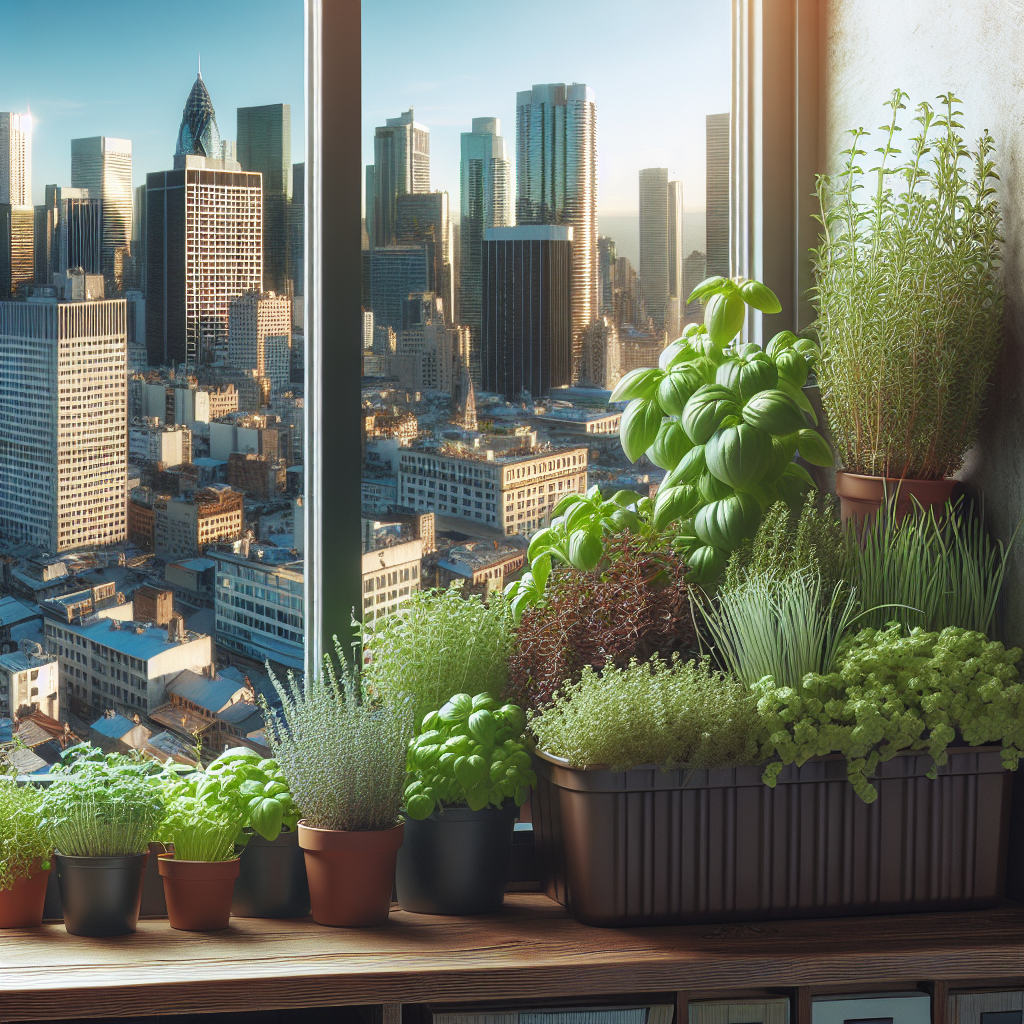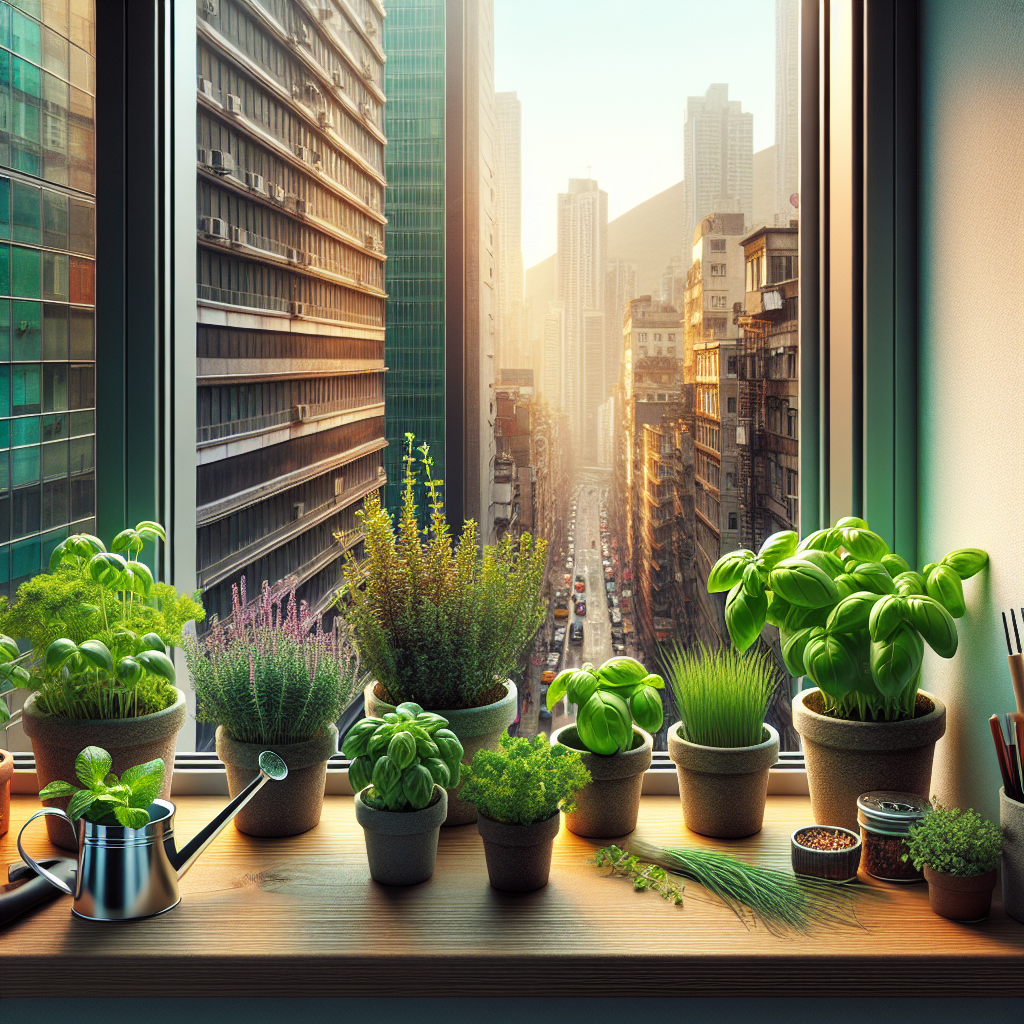
Imagine being able to step into your kitchen and pluck fresh herbs from your own mini garden, right on your windowsill. With urban living becoming increasingly popular, finding ways to connect with nature is a challenge. But fear not! In this article, we will share some valuable tips and tricks on creating a productive herb garden in the city, all from the comfort of your own home. Whether you have a green thumb or are completely new to gardening, these simple steps will have you growing and enjoying your own fresh herbs in no time. Say goodbye to store-bought herbs and hello to a more sustainable and aromatic culinary experience. Let’s get started!

Choosing the Right Herbs
When it comes to starting your own herb garden on a windowsill, it’s important to choose the right herbs that will thrive in the limited space and conditions of a city environment. Here are a few factors to consider:
Consider the available sunlight
Before selecting your herbs, take a look at the amount of sunlight your windowsill receives throughout the day. Most herbs require at least six hours of direct sunlight to grow well, so choose herbs that can tolerate the available light. Some sun-loving herbs include basil, thyme, rosemary, and oregano.
Select low-maintenance herbs
If you’re a busy individual or a beginner in gardening, it’s advisable to opt for low-maintenance herbs. These herbs are more forgiving and require less attention. Some examples of low-maintenance herbs are mint, chives, sage, and parsley. They can tolerate a variety of growing conditions and require minimal care.
Choose herbs that suit your culinary preferences
The herbs you choose should align with your culinary preferences. Consider the types of dishes you enjoy cooking and the flavors you like to incorporate. If you enjoy Italian cuisine, basil and oregano would be great choices. For Asian-inspired dishes, cilantro and Thai basil would be fitting. By choosing herbs that suit your tastes, you’ll have a fresh and readily available supply of ingredients for your favorite meals.
Preparing the Windowsill
Before you can begin planting your herbs, it’s crucial to ensure that your windowsill is properly prepared to provide the optimal environment for their growth. Here are a few steps to follow:
Clean the windowsill
Start by thoroughly cleaning your windowsill to remove any dust, dirt, or residue. Use a mild soap or a vinegar solution to clean the surface. This ensures that your herbs will be growing in a clean and hygienic environment.
Ensure proper drainage
Proper drainage is essential to prevent waterlogging and root rot. Choose containers with drainage holes or add drainage materials like pebbles or activated charcoal to the bottom of each pot. This will help excess water to flow out freely and avoid creating a waterlogged environment for your herbs.
Provide adequate space for each herb
Make sure you have enough space on your windowsill to accommodate each herb comfortably. Crowded herbs may not receive enough airflow and sunlight, which can impact their growth. Additionally, give each herb enough space to spread its roots and grow without being hindered by neighboring plants. Aim to provide at least a 6-inch space between each herb.
Selecting Containers
Choosing the right containers for your herb garden is crucial for their overall health and productivity. Here’s what you need to consider:
Opt for lightweight and portable containers
Since your herb garden will be on a windowsill, it’s important to choose containers that are lightweight and portable. This will make it easier for you to move the herbs around if needed or when cleaning the windowsill. Plastic or fabric containers are good options as they are lightweight and have the added benefit of providing insulation for the roots.
Choose containers with drainage holes
As mentioned earlier, proper drainage is vital for the health of your herbs. Select containers that have drainage holes in the bottom to allow excess water to escape. This prevents waterlogging and ensures that the roots have access to the oxygen they need.
Consider the size and depth of the containers
The size and depth of your containers are important factors to consider. While herbs don’t need large containers, they should have enough space for their roots to spread comfortably. A depth of at least 4-6 inches is typically sufficient for most herbs. However, keep in mind that some herbs, such as mint, have invasive root systems and may require deeper containers to prevent them from becoming root-bound.
Choosing the Right Growing Medium
The growing medium directly affects the health and growth of your herbs. Here are a few tips for selecting the right medium:
Use a well-draining soil mix
Herbs prefer soil that is well-draining to prevent the roots from sitting in stagnant water. Choose a potting mix specifically formulated for herbs or create your own blend by combining equal parts of compost, perlite, and vermiculite. This mixture will promote proper drainage while supplying the necessary nutrients for your herbs.
Consider adding compost or organic matter
To provide additional nutrients and improve soil fertility, consider incorporating compost or organic matter into your growing medium. Compost enriches the soil with essential nutrients, enhances moisture retention, and encourages the development of beneficial microorganisms. You can either make your own compost or purchase it from a garden center.
Avoid using soil from the garden
While it may be tempting to use soil from your garden, it’s generally not recommended for growing herbs indoors. Garden soil may contain pests, diseases, or weed seeds that can negatively impact your indoor herb garden. Additionally, garden soil tends to be denser and less well-draining than potting mixes, which can lead to waterlogging and root rot.

Watering and Moisture
Proper watering is key to ensuring the health and productivity of your herbs. Here’s what you need to know:
Water herbs properly and consistently
Herbs prefer to be kept evenly moist but not overly saturated. Water your herbs when the top inch of soil feels dry to the touch. Use a watering can or a spray bottle to gently water the soil until water comes out through the drainage holes. Avoid wetting the leaves excessively, as this can encourage fungal diseases.
Avoid overwatering
Overwatering is one of the most common mistakes made by novice gardeners. It’s important to strike a balance and not drown your herbs with excessive water. Too much water can lead to root rot, wilting, and overall poor growth. Always ensure proper drainage and allow the top layer of soil to dry out slightly before watering again.
Use a tray or saucer to collect excess water
To prevent water from damaging your windowsill or creating a mess, place a plastic or ceramic tray or saucer beneath your herb pots. This will collect any excess water that drains out and can be easily emptied. Ensure that the pots are not sitting directly in the collected water, as this can also cause root rot.
Providing Adequate Light
Herbs require ample sunlight to thrive and produce flavorful leaves. Here’s how you can provide them with the right lighting conditions:
Place herbs in a sunny location
Position your herb garden in a sunny location near a south-facing window if possible. Most herbs need at least six hours of direct sunlight each day to grow well. Ensure that there are no obstructions like curtains or blinds blocking the light. If you don’t have a suitable window, consider using a grow light to supplement the natural light.
Supplement natural light with artificial lighting
If your windowsill doesn’t receive enough sunlight, especially during the winter months, you can supplement the natural light with artificial lighting. LED or fluorescent grow lights are excellent options for indoor herb gardens. Position the lights approximately 6-12 inches above the herbs and keep them on for about 12-16 hours a day to mimic sunlight.
Rotate herbs for even exposure
To ensure that all your herbs receive equal exposure to light, rotate them regularly. Herbs tend to grow towards the light, causing uneven growth if they are not turned regularly. Rotate the pots every few days to promote even growth and avoid any leggy or lopsided plants.

Temperature and Humidity
Maintaining the right temperature and humidity levels is essential for the overall health and productivity of your herbs. Here’s what you need to keep in mind:
Maintain the ideal temperature range
Most herbs thrive in temperatures between 60°F to 75°F (15°C to 24°C). Avoid exposing your herbs to extreme temperature fluctuations, such as placing them near drafts or heating vents. Keep them away from windows during cold winter nights to protect them from cold drafts. If necessary, use a thermometer to monitor the temperature in your growing area.
Increase humidity if necessary
City environments can often be dry, especially during winter when indoor heating is used. To increase humidity around your herbs, mist them with water regularly or place a tray filled with water near the plants. As the water evaporates, it will create a more humid environment around your herbs. Just be cautious not to mist the leaves excessively to prevent fungal diseases.
Protect herbs from extreme temperature fluctuations
Herbs are sensitive to sudden temperature changes. Avoid placing them near air conditioning vents or open windows during extremely hot or cold weather. Sudden temperature fluctuations can stress the herbs and negatively affect their growth and health. If possible, provide some insulation around the pots during extreme weather conditions.
Pruning and Harvesting
Pruning and harvesting your herbs properly is important for promoting healthy growth and prolonging their productivity. Here’s what you need to know:
Trim herbs regularly to promote growth
Regular trimming encourages bushier and more productive growth in your herbs. Pinch or trim the tops of the plants when they reach a height of 4-6 inches. This helps to stimulate branching and prevents the herbs from becoming leggy or lanky. Ensure that you only remove a maximum of one-third of the plant at a time to avoid stressing it.
Harvest herbs at the right time
Harvesting your herbs at the right time ensures the best flavor and quality. Most herbs are tastiest when harvested before they flower. Harvest in the morning when the leaves are at their freshest. Use sharp scissors or pruners to cut the stems just above a set of healthy leaves or nodes. Regular harvesting also prevents the herbs from becoming overcrowded.
Avoid over-harvesting
While it’s exciting to have fresh herbs at your fingertips, it’s important to avoid over-harvesting your plants. Removing too many leaves at once can weaken the plant and reduce its ability to produce new growth. Allow your herbs to grow and establish themselves before harvesting too heavily. Remember, you can always harvest more later as needed.

Fertilizing the Herbs
Proper fertilization ensures that your herbs receive the necessary nutrients for optimal growth and productivity. Follow these tips to fertilize your herbs effectively:
Choose a balanced fertilizer
Select a balanced fertilizer specifically formulated for herbs or vegetables. Look for a fertilizer with an approximate ratio of 10-10-10 or 14-14-14, indicating the percentage of nitrogen, phosphorous, and potassium, respectively. A balanced fertilizer provides the necessary nutrients for healthy foliage, root development, and overall plant growth.
Follow the recommended dosage
Always follow the instructions on the fertilizer packaging for the correct dosage and application method. Over-fertilizing can lead to nutrient burn or excessive vegetative growth at the expense of flavor and aroma. Remember to adjust the dosage based on the size of your containers and the number of herbs you’re growing.
Use organic fertilizers for a natural approach
If you prefer a more natural approach, organic fertilizers are a great option. Organic fertilizers release nutrients slowly and enrich the soil with organic matter, improving its structure and fertility. Examples of organic fertilizers include compost, worm castings, and seaweed-based fertilizers. Just ensure that you use them in moderation to avoid nutrient imbalances.
Troubleshooting Common Issues
Even with the best care, herb gardens can face certain challenges. Here are a few common issues and how to address them:
Identify and address nutrient deficiencies
If your herbs show signs of nutrient deficiencies, such as pale or yellowing leaves, stunted growth, or poor flavor, it’s important to address the issue promptly. Add a balanced fertilizer according to the package instructions to provide the missing nutrients. Alternatively, you can incorporate compost or organic matter into the soil to naturally enrich it.
Prevent root rot and fungal diseases
Overwatering and poor drainage can cause root rot and create a favorable environment for fungal diseases. To prevent these issues, ensure proper drainage by using containers with drainage holes and a well-draining soil mix. Water your herbs appropriately, allowing the top layer of soil to dry out slightly before watering again. Avoid wetting the leaves excessively.
Revive wilted or weakened herbs
If your herbs appear wilted or weakened, it may be a sign of underwatering or root damage. Check the moisture level of the soil and adjust your watering schedule if necessary. If the herbs are severely wilted, try immersing the entire pot in a basin of water for a short period to rehydrate the roots. Trim any damaged or diseased foliage and provide proper care to encourage recovery.
By following these tips, you can create a productive and flourishing herb garden on your windowsill in the city. Enjoy the convenience of having fresh and flavorful herbs at your fingertips, and elevate your culinary creations with the vibrant tastes and aromas of homegrown herbs. Happy gardening!






